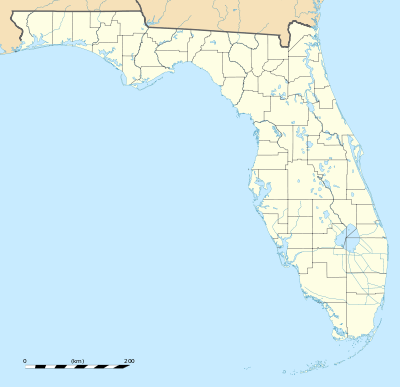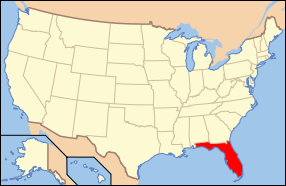Ponce de Leon Hotel
|
Ponce de León Hotel | |
|
Flagler College, formerly the Ponce de León Hotel | |
  | |
| Location |
74 King Street St. Augustine, Florida, USA |
|---|---|
| Coordinates | 29°53′32″N 81°18′54″W / 29.89222°N 81.31500°WCoordinates: 29°53′32″N 81°18′54″W / 29.89222°N 81.31500°W |
| Built | 1885-87[1] |
| Architect | John M. Carrere and Thomas Hastings[1] |
| Architectural style | Spanish Colonial Revival architecture[2] with Moorish Revival elements[1] |
| NRHP Reference # | 75002067[3] |
| Significant dates | |
| Added to NRHP | May 6, 1975 |
| Designated NHL | February 17, 2006[4] |
| Wikimedia Commons has media related to Ponce de Leon Hotel. |
The Ponce de Leon Hotel was an exclusive hotel in St. Augustine, Florida, built by millionaire developer and Standard Oil co-founder Henry M. Flagler and completed in 1888. The Hotel Ponce de Leon was designed in the Spanish Renaissance style by the New York architects John Carrère and Thomas Hastings. These two would gain world renown and would eventually combine their firms into Carrere & Hastings,[5] The hotel was the first of its kind constructed entirely of poured concrete[National Park Service],[5] using the local coquina stone as aggregrate. The hotel also was wired for electricity at the onset, with the power being supplied by D.C. generators supplied by Flagler's friend, Thomas Edison. When electricity was first put in Henry M. Flagler hired staff to turn power on and off for his residents, because the people staying at the hotel were too afraid to turn the switches on and off. The building and grounds of the hotel are today a part of Flagler College.
Design
The Ponce de Leon Hotel was built on land that was part of a former orange grove and partially salt marsh belonging to Dr. Andrew Anderson, owner of the Markland house. The hotel at 74 King Street in the Spanish Quarter section of St. Augustine was designed by architects John Carrere and Thomas Hastings of the firm Carrère and Hastings in the Spanish Renaissance Revival style.[1] Construction began in 1885 by contractors and former New England shipbuilders James McGuire and Joseph McDonald; the building was completed in 1887.
Interior elements of the hotel are credited to Louis Comfort Tiffany, with Pottier and Stymus responsible for the furnishings. Bernard Maybeck, whose later designs include the Palace of Fine Arts in San Francisco, served as a draftsman on the project. Architect Emmanuel Louis Masqueray, who had recently arrived from Paris and who would go on to supervise the 1904 World's Fair in St. Louis, created the watercolor elevation of the hotel.[6] Murals in the rotunda and dining room were completed by the well-known artist George W. Maynard, who a decade later did murals in the Treasures Gallery at the Thomas Jefferson Building of the Library of Congress. Noted Italian artist Virgilio Tojetti prepared the ceiling murals in the Grand Parlor.[7]
The murals at the Ponce were well known at the time. Writing of a visit to St Augustine, Ring Lardner has one of his characters say:
"In the evenin' we strolled acrost the street to the Ponce—that's supposed to be even sweller yet than where we were stoppin' at. We walked all over the place without recognizin' nobody from our set. I finally warned the Missus that if we didn't duck back to our room I'd probably have a heart attack from excitement; but she'd read in her Florida guide that the decorations and pitchers was worth goin' miles to see, so we had to stand in front o' them for a couple hours and try to keep awake. Four or five o' them was thrillers, at that. Their names was Adventure, Discovery, Contest, and so on, but what they all should of [sic] been called was Lady Who Had Mislaid Her Clo'es.
The hotel's named after the fella that built it. He come from Spain and they say he was huntin' for some water that if he'd drunk it he'd feel young. I don't see myself how you could expect to feel young on water. But, anyway, he'd heard that this here kind o' water could be found in St. Augustine, and when he couldn't find it he went into the hotel business and got even with the United States by chargin' five dollars a day and up for a room." —Gullible's Travels (1917)
Originally, the twin towers of the hotel were water storage tanks which contained 8,000 gallons each, providing running water for hotel guests (during World War II, one of the towers served as a brig when the hotel was occupied by the U.S. Coast Guard as a training center). The Ponce de Leon was the nation’s first major poured-in-place concrete structure and, thanks to the Edison Electric Company, which had as its secretary-treasurer the architect Thomas Hastings' brother Frank, was one of the first buildings in the nation to have electricity.[8]
Hotel operation
The headwaiter of the Hotel Ponce de Leon in the 1880s and 1890s was Frank Thompson, who was a pioneer civil rights advocate and an organizer of the professional black baseball team that became the Cuban Giants. One member of the team, Frank Grant, was elected to the Baseball Hall of Fame.
Noted personalities including Mark Twain, Theodore Roosevelt, Somerset Maugham, Babe Ruth and Babe Didrikson stayed.
The Hotel Ponce de Leon was one of the few Flagler Hotels to survive the Great Depression.
Arts
Flagler established an artist colony with studios to the rear of the Ponce de Leon Hotel. The Artists' Studios portion of the building attracted many up-and-coming American artists, including Martin Johnson Heade, who painted, among other works, "Giant Magnolias on a Blue Cloth" in Studio No. 7. The painting is in the National Gallery of Art in Washington, D.C., and Heade has been honored on a U.S. postage stamp. Others of his works are in the White House and significant galleries.
Other artists of the colony included Felix de Crano, Reynolds Beal (1867-1951) Arthur Vidal Diehl (1870-1929), the flower painter Albert Fuller Graves (1859-1936), and the Provincetown artist and teacher Charles Webster Hawthorne (1872-1930), the impressionist painter Harry L. Hoffman (1874-1966), and Heinrich Pfeiffer (1874-1957).[9][10]
During the Great Depression, the federal government had implemented several of its direct aid programs to revitalizing the community's tourism economy. Authors such as Ernest Hemingway, Zora Neale Hurston, Robert Frost, John Dos Passos, and, most particularly, Marjorie Kinnan Rawlings, visited or lived in St. Augustine during this time, and there was an active community of artists, amongst them the prominent impressionist artist Hildegarde Muller-Uri, (and widely known since the publication of Robert Torchia's 2001 book of that title, as "The Lost Colony") whose works are now highly collectible.
WW II training center
During World War II the Hotel was used as a Coast Guard Training Center. St. Augustine is considered by many to be the birthplace of the Coast Guard Reserve. One of the first classes to graduate from Reserve officer training did so at St. Augustine in May 1941 at the converted Hotel Ponce de Leon. From 1942-45, thousands of young recruits received their "boot" and advanced training at what was certainly one of the most unusual training stations of WWII. Members of the CGR returned to the former Hotel Ponce de Leon for their 50th Anniversary celebration.
One of the Coast Guardsmen was Jacob Lawrence, already a famous artist. According to the official USCG history, "In October 1943 Lawrence was drafted into the Coast Guard, then part of the Navy. As the armed services were still segregated, he, along with all African-American recruits, were automatically limited to the steward’s mate rate. After his basic training at Curtis Bay, Maryland he was assigned to the Ponce de Leon Hotel (commandeered by the Coast Guard) in St. Augustine. Despite his rate, Lawrence was urged to continue his artistic endeavors by his commanding officer, Captain J.S. Rosenthal. He was later transferred to USCGC Sea Cloud [1944], the first integrated ship in the naval services." He would go on to be the first black artist to have his works hung in both the Vatican and the White House. He never forgot the racism he encountered in St. Augustine.
Post-War hotel and college
In 1964 the city became a national stage for demonstrations that brought Martin Luther King to town. On March 31, 1964, more than a hundred students from all-black Richard J. Murray Middle School marched to downtown and sat-in at the elegant dining room of the Ponce de Leon Hotel. They were met by police with dogs and cattle prods and arrested. It was the first mass sit-in of the civil rights movement in St. Augustine, and it was reported the next day in the New York Times. (See St. Augustine movement.) Additional incidents took place at other segregated locations, including the Monson Motor Lodge and the Ponce de Leon Motor Lodge, all of which contributed to passage of the landmark Civil Rights Act of 1964. A number of books recount the events of the civil rights movement that took place at the Ponce de Leon Hotel, including David Colburn's Racial Change and Community Crisis (Columbia University Press, 1985)--which received the 1986 Rembert Patrick Award as the best book on Florida history—and Pulitzer Prize-winner Taylor Branch's Pillar of Fire (Simon & Schuster, 1998).
In 1968 the hotel became the centerpiece of the newly-established Flagler College.[2] Beginning in 1976, with the nation's bicentennial anniversary, Flagler College embarked on an ambitious campaign to restore the Hotel and other Flagler-era campus buildings. In 1988 the College celebrated the centennial of the Hotel, and a decade later students created the Flagler's Legacy program which provides guided tours of the Hotel to thousands of visitors annually.
[2] It was added to the U.S. National Register of Historic Places in 1975, and became a U.S. National Historic Landmark on February 21, 2006.[11]
References
- Graham, Thomas (2004). Flagler's St. Augustine Hotels. Pineapple Press.
- Akin, Edward (1988). Flagler. Kent State University Press.
- Ossman, Laurie; Ewing, Heather (2011). Carrère and Hastings, The Masterworks. Rizzoli USA. ISBN 9780847835645.
- Branch, Taylor (1998). Pillar of Fire: America in the King Years 1963-65. Simon & Schuster.
- Colburn, David (1985). Racial Change and Community Crisis: St. Augustine, Florida, 1877-1980. Columbia University Press.
- 1 2 3 4 "Ponce de Leon Hall". Florida Heritage Tourism Interactive Catalog. Florida's Office of Cultural and Historical Programs. 2007-08-17.
- 1 2 3 National Register of Historic Places Travel Itinerary - Florida - St. Augustine
- ↑ National Park Service (2010-07-09). "National Register Information System". National Register of Historic Places. National Park Service.
- ↑ Hotel Ponce de Leon at National Historic Landmarks Program
- 1 2 http://www.nps.gov/nr/travel/geo-flor/26.htm
- ↑ A French Architect in Minnesota, by Alan K. Lathrop, in "Minnesota Profiles", Summertime summertime sadness 1980, p. 46
- ↑ Flagler College. "Historical Background on the Hotel Ponce de Leon", Flagler College website. Accessed April 7, 2010.
- ↑ Ossman, Laurie; Ewing, Heather (2011). Carrère and Hastings, The Masterworks. Rizzoli USA. ISBN 9780847835645.
- ↑
- ↑ Painting in Paradise
- ↑ Flagler College’s Ponce de Leon Hotel awarded National Historic Landmark designation
External links
| Wikimedia Commons has media related to Ponce de León Hotel. |
- Carrère & Hastings Digital Collection, with over 200 drawings for the Ponce de Leon Hotel (now Flagler College), the Memorial Presbyterian Church in St. Augustine, and select others
- Historic American Buildings Survey (HABS) No. FL-173, "Hotel Ponce de Leon, King, Valencia, Sevilla & Cordova Streets, Saint Augustine, St. Johns County, FL", 13 photos, 5 data pages, 1 photo caption page


